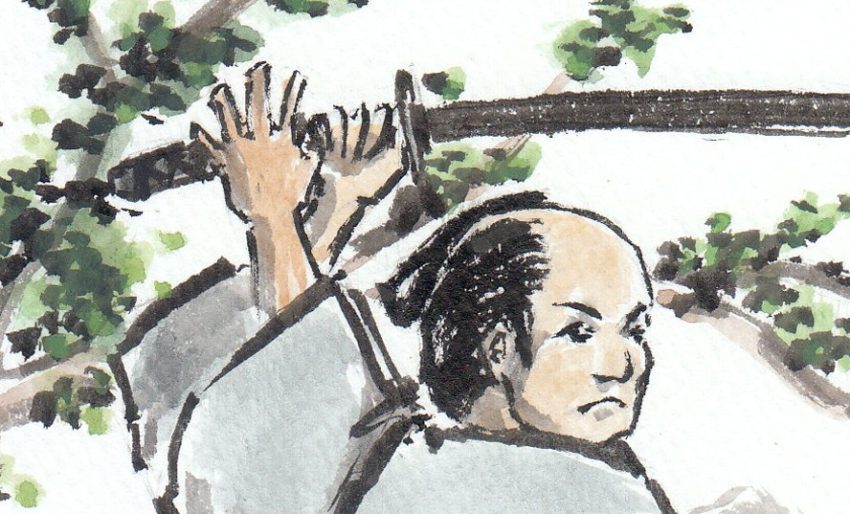The nodachi sword, which has also been known as the odachi, is a weapon from Japanese history that many will find is relatively unknown to the western world. The first thing that many notice is that this two-handed Japanese sword resembles an elongated katana, and while the comparison is apt, it also has similarities to the claymore of the west.
If you look at the kanji for odachiODACHI 大太刀 "large tachi sword" learn more..., 大太刀, the first character 大, which is dai, is typically used to denote largeness. The very term odachi can be loosely translated to “great sword.” When you first look at one of these blades, you’ll definitely notice that it dwarfs many of its contemporaries. There’s even a legend that some variations of this blade could only be adequately wielded by a giant!
As a rule, for a Japanese sword to be considered a nodachiNODACHI 野太刀 "field sword" learn more..., it needs to be about 36 inches or longer. Similar to its western and eastern greatsword cousins, the nodachi was designed to be slightly heavier than other Japanese swords. The warrior that wielded it had to have a high level of skill to use his weapon effectively.
Usually, this sword would be massive, as much as 10 pounds, which meant that executing an extensive swing could definitely be more complicated than many of the other nihontoNIHONTO 日本刀 "Japanese sword" learn more... throughout the illustrious history of the island nation.
Still, when used correctly, a two-handed Japanese sword could be devastating, especially when used against horse-mounted cavalry. In addition to the massive blade length, the hilt of the sword was also much longer than was traditional for a katanaKATANA 刀 "sword" learn more..., and this extra length made it easier for swordsmen to swing the blade with force and accuracy.
The History of the Two-Handed Japanese Sword
The first odachi started to appear during the Heian Period, which was a time in Japan that extended from 794 AD to around 1185. The location of Heian-Kyo eventually became known as Kyoto, and it was in this city that the seat of Japanese imperial society really started to take root. The legendary Japanese literary epic, The Tale of Genji, originated during this imperial era.
The Heian Period was also a time of increasing military strife. Engagements like the Genpei War and the Hogen Rebellion necessitated a new military class. These conscripted warriors in turn required new weapons that could be used on the constantly-evolving battlefield.
While now-traditional weapons like the katana and the wakizashiWAKIZASHI 脇差 or 脇指 "medium-length sword" learn more... would not appear until the later Kamakura Period, the odachi was already seeing extensive use by skilled samurai on the battlefield. Due to its extended length and high accuracy, this weapon served as a reliable weapon to use against mounted warriors. As a result, the odachi gained a reputation for its ability to kill either horse or rider, or sometimes both, with a single downward cut.
Like other Japanese swords, martial arts developed around the use of this powerful two-handed Japanese sword. In fact, various techniques were developed that enabled the sometimes cumbersome sword to be drawn from its scabbard relatively quickly.
Over the years, the use of this sword started to take on new dimensions and eventually, in addition to its use in martial affairs, the sword began to be used as ceremonial swords in events designed to bring honor to the gods. The weapons’ beautiful craftsmanship and unique sizing made them perfect for celebrating the members of the Japanese pantheon. As a result, many of the shrines across the nation would have their own offered nodachi. To this day, previously-unknown ceremonial two-handed Japanese sword offerings continue to be unearthed.
Additionally, over time, while the sword started to wane in popularity, the odachi started to become something of a glamour weapon. With its larger blade, it was co-opted by rich nobles as a centerpiece of their collection, and skilled smiths that could forge beautiful nodachi became high in demand.
Practical Use of the Nodachi
As we’ve seen, this wasn’t a sword that just any foot soldier could use with ease. You had to be a very skilled swordsman to wield an outsized two-handed Japanese sword with any effectiveness. For one thing, unlike other swords of the era, this wasn’t a weapon that could be used indoors; it was simply too big. So if the enemy retreated into some enclosed structure, nodachi-wielding samurai were out of luck.
Also, these weren’t really designed to be used in drawn-out confrontations. The nodachi could only be used effectively on the downstroke, and if it was to be swung, it was always best to swing with 100 percent surety that the cut would be fatal.
This nihonto was also difficult to draw. With the daishoDAISHO 大小 "big and small" learn more..., you could easily draw both the katana and its partnered wakizashi from your waist with relative ease. Both swords were designed to be drawn quickly so that any slashes would be decisive. Arts like iaidoIAIDO 居合道 "art of drawing a sword" learn more... focused extensively on drawing the blade and making super-fast cuts.
With a nodachi, this was impossible because the blade could not be worn comfortably on the waist or back due to its length. And speaking of the latter area of the body, drawing a two-handed sword from your back also took time. Many samurai would wield shorter weapons in addition to their nodachi so that they could still battle in closer quarters. It began to call the whole idea of carrying around a nodachi into serious question.
Samurai of the era would bring in squire-like assistants or servants to help them draw the blade, but as time advanced some samurai clans did develop ways to draw the blade with a little more alacrity. These included drawing away the sheath instead of the sword, a clever rethinking which sped the process significantly. Also, when used, many warriors simply carried the sheathed sword around by hand. This made it easier to draw – though carrying such a long sword around could obviously be cumbersome.
The Norimitsu Nodachi
Amongst some of the most famous swords in Japanese history is the Norimitsu Nodachi. This greatsword is perhaps the greatest of all Japanese two-handed swords due to the fact that it is almost 13 feet in length! By all stretches of the imagination, this is simply too large to be used at all, even by the most skilled of swordsmen. On top of this exceptional length, the colossal sword weighs almost 32 pounds.
The Norimitsu sword originated in 15th century Japan, and its precise usage is unknown. The legend around this blade implies that it was once used by a giant Japanese warrior, but there’s no evidence that this is anything other than myth.
The common belief is that this blade was primarily designed to be a status symbol or as a representation of the skills of a famous sword fighter. Today, the Norimitsu Nodachi can be found at Kibitsu Shrine in Okayama, on the main Japanese island of Honshu. If you ever visit, make sure to check out the shrine to see one of the largest swords in history!
Why the Two-Handed Japanese Sword Went Out of Fashion
Based on the historical records of the time, the primary use of the nodachi extended for hundreds of years and experienced a burst of popularity in the Nanboku-chou period, which was in 14th century Japan. Popularity continued to wane until around 1615, by which time the weapon had almost completely fallen into disfavor. Here are a few reasons why:
- It was impractical. As we’ve covered, drawing the blade was difficult, and since you couldn’t use it indoors, greatsword-wielding samurai were at a distinct disadvantage. Also, to forge a nodachi was considered very difficult, and if formed improperly, the blade could easily snap and become useless. Finally, just drawing it required a lot of forethought and planning.
- There was less need. After the 17th century, Japan simply experienced less war among mounted combatants. As a result, there was a reduced need for the nodachi on the battlefield. Also, this is the era when firearms started to appear in Japanese conflicts. Notably, this was the time of the Tokugawa Shogunate, when samurai, Japan’s traditional warriors, began to take on other roles.
- The Meiji Restoration. With Western influence mainly on the rise during the 19th century, all bladed weapons started to fall out of favor. They were eventually banned outright by Emperor Meiji.
How to Determine Whether a Nodachi is of High Quality
If you’d like to own a piece of Japanese history by buying one of these unique Japanese greatswords, then it’s a good idea to determine the quality of the weapon first. As you’ve seen, forging one of these for quality can be difficult. Over the centuries, however, the still-complicated manufacturing process has improved significantly. Today, stainless steel is the primary material used for most consumer-grade nodachi. But if you want one that will last and has a good level of strength, then carbon steel is a great option to consider.
Both types can achieve exquisite looks and designs. You don’t have to spend thousands of dollars to get a beautiful weapon that will stand as the centerpiece of your collection – although you certainly could if you have the means and you spot the right sword for sale!
Final Thoughts
The nodachi is undoubtedly a unique two-handed Japanese sword that is beautiful to look at and deeply embedded in Japanese martial history. In fact, despite their relative obscurity in the west, there have been examples of nodachi in video games and other forms of popular culture. If you’re thinking of purchasing one, know that there’s a lot of history behind these greatswords from the Heian Period.

